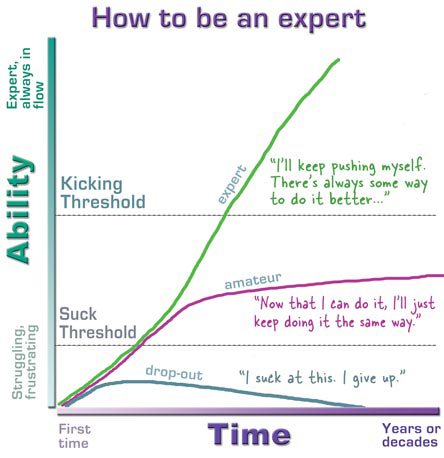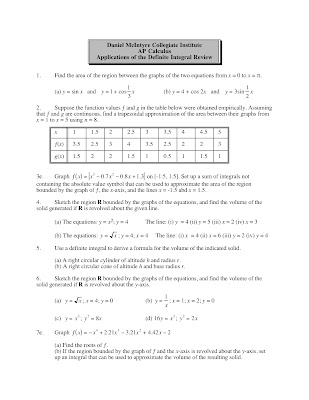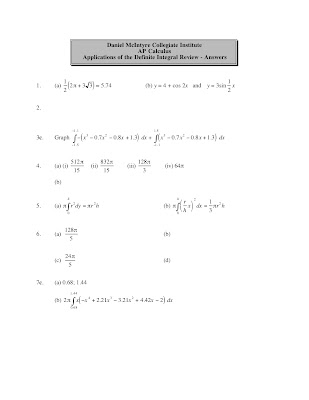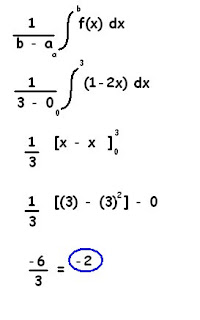You can take a sneak peak at the new blog here.
Click that picture ... there's a great article at the other end of that link.

An interactive learning ecology for students and parents in my AP Calculus class. This ongoing dialogue is as rich as YOU make it. Visit often and post your comments freely.

The teaching of mathematical concepts is the main focus of this project; so we can teach other people and learn at the same time.
Acheivement Descriptors
Instead of levels 1-4 (lowest to highest) we use these descriptors. They better describe what this project is all about.
Novice: a person who is new to the circumstances, work, etc., in which he or she is placed; a beginner.
Apprentice: to bind to or place with a master craftsman, or the like, for instruction in a trade.
Journeyperson: any experienced, competent but routine worker or performer.
Expert: possessing special skill or knowledge; trained by practice; skillful or skilled.
| Acheivement | Mathematical Challenge (25%) | Solutions (55%) | Presentation (20%) |
| Novice | Problems illustrate only an introductory knowledge of the subject. They may be unsolvable or the solutions to the problems are obvious and/or easy to find. They do not demonstrate mastery of the subject matter. | One or more solutions contain several errors with insufficient detail to understand what's going on. Explanation does not "flow," may not be in sequential order and does not adequately explain the problem(s). May also have improper mathematical notation. | Presentation may or may not include visual or other digital enhancements. Overall, a rather uninspired presentation. Doesn't really stand out. It is clear that the student has invested little effort into planning their presentation. |
| Apprentice | Problems are routine, requiring only modest effort or knowledge. The scope of the problems does not demonstrate the breadth of knowledge the student should have acquired at this stage of their learning. | One or more solutions have a few errors but are understandable. Explanation may "flow" well but only vaguely explains one or more problems. Some parts of one or more solutions are difficult to follow. May include improper use of mathematical notation. | The presentation style is attractive but doesn't enhance the content; more flashy than functional. It is clear that the student has invested some effort into planning their presentation. |
| Journeyperson | Not all the problems are "routine" in nature. They span an appropriate breadth of material. At least one problem requires careful thought such as consideration of a special case or combines concepts from more than one unit. Showcases the writer's skill in solving routine mathematical problems. | All solutions are correct and easy to understand. Very few or no minor errors. Explanation "flows" well and explains the problems step by step. Solution is broken down well and explained in a way that makes it easy to follow. May have minor use of improper mathematical notation. May point out other ways of solving one or more problems as well. | The presentation may use multiple media tools. The presentation style is attractive and maintains interest. Some of the underlying message may be lost by some aspects that are more flashy than functional. It is clear that the student has given some forethought and planning to their presentation. |
| Expert | Problems span more than one unit worth of material. All problems are non-routine. Every problem includes content from at least two different units. Problems created demonstrate mastery of the subject matter. Showcases the writer's skill in solving challenging mathematical problems. | All solutions correct, understandable and highly detailed. No errors. Explanation "flows" well, explains the problems thoroughly and points out other ways of solving at least two of them. | The presentation displays use of multiple media tools. The presentation style grabs the viewer's or reader's attention and compliments the content in a way aids understanding and maintains interest. An "eye opening" display from which it is evident that the student invested significant effort. |
Creativity (up to 5% bonus)
The maximum possible mark for this assignment is 105%. You can earn up to 5% bonus marks for being creative in the way you approach this assignment. This is not a rigidly defined category and is open to interpretation. You can earn this bonus if your work can be described in one or more of these ways:




 We have Kg/m2 and we want to get kg, so we have to get rid of the m2
We have Kg/m2 and we want to get kg, so we have to get rid of the m2 


With the help of Fooplot http://www.fooplot.com/, we were able to see what the graph looked like. Points of intersection tell you where to integrate.
So that brings us to the end. If you're still having trouble, the slides from Thursdays class http://www.slideshare.net/gofull/30241/1 are up.. thank goodness for our super-di-duper smartboard!!! HMWK for the weekend is EXC 8.5 # 1,3,5,11,15. And by the way, MARK is the scribe for Monday! Enjoy the rest of your weekend guys =)

 The Assignment
The Assignment Q: Where did this formula come from?
Q: Where did this formula come from?

 According to our Average Value rules, we need to add all the outputs and divide it by the number of intervals used. Therefore...
According to our Average Value rules, we need to add all the outputs and divide it by the number of intervals used. Therefore...  We substituted the formula for n in the denominator. The formula boxed in red is the Riemann Sum. The "E" symbolized the summation of all the outputs in the function, "f". "x" is a constant since the width of an interval never changes. The number of intervals will go to infinity to get the area under the curve. The limit and the summation are symbolized by the integral from [a,b].
We substituted the formula for n in the denominator. The formula boxed in red is the Riemann Sum. The "E" symbolized the summation of all the outputs in the function, "f". "x" is a constant since the width of an interval never changes. The number of intervals will go to infinity to get the area under the curve. The limit and the summation are symbolized by the integral from [a,b].
Example:
Find the average value of the given function on the given interval.
f(x) = 1 - 2x [0,3]
Using the average value formula for functions, we can get the average value...
Then, we talked about the Mean Value Theorem for Integrals.
If we recall, the Mean Value Theorem for Derivatives state that: Let f be continuous on a closed interval, [a,b]. There lies a value "c" that is equal to the rate of change of the curve.
The Mean Value Theorem for Integrals state that: Let f be continuous on a closed interval [a,b]. Then there exists "c" in the closed interval such that...
 I think that's all we did in class. Next scribe is... err.... I'm not sure who to pick. XD I'll just pick during the next class.
I think that's all we did in class. Next scribe is... err.... I'm not sure who to pick. XD I'll just pick during the next class.


 Volume has three dimensions, and Area has two. By integrating, we are essentially finding the thickness of an object. Going back to the equation V = (thickness)(length)(width), one dimension is already accounted for. We only need to find two more, and this is the area of the cross section.
Volume has three dimensions, and Area has two. By integrating, we are essentially finding the thickness of an object. Going back to the equation V = (thickness)(length)(width), one dimension is already accounted for. We only need to find two more, and this is the area of the cross section. A(x) is the function representing the changing areas. The area for all the cross sections is represented by A = πr2, but r varies, so we need a function that represents r.
A(x) is the function representing the changing areas. The area for all the cross sections is represented by A = πr2, but r varies, so we need a function that represents r.



